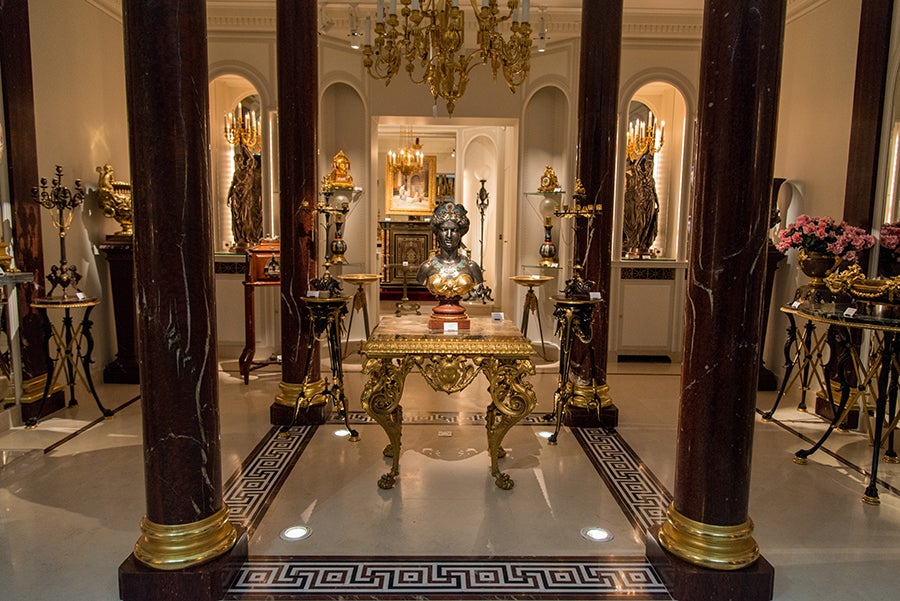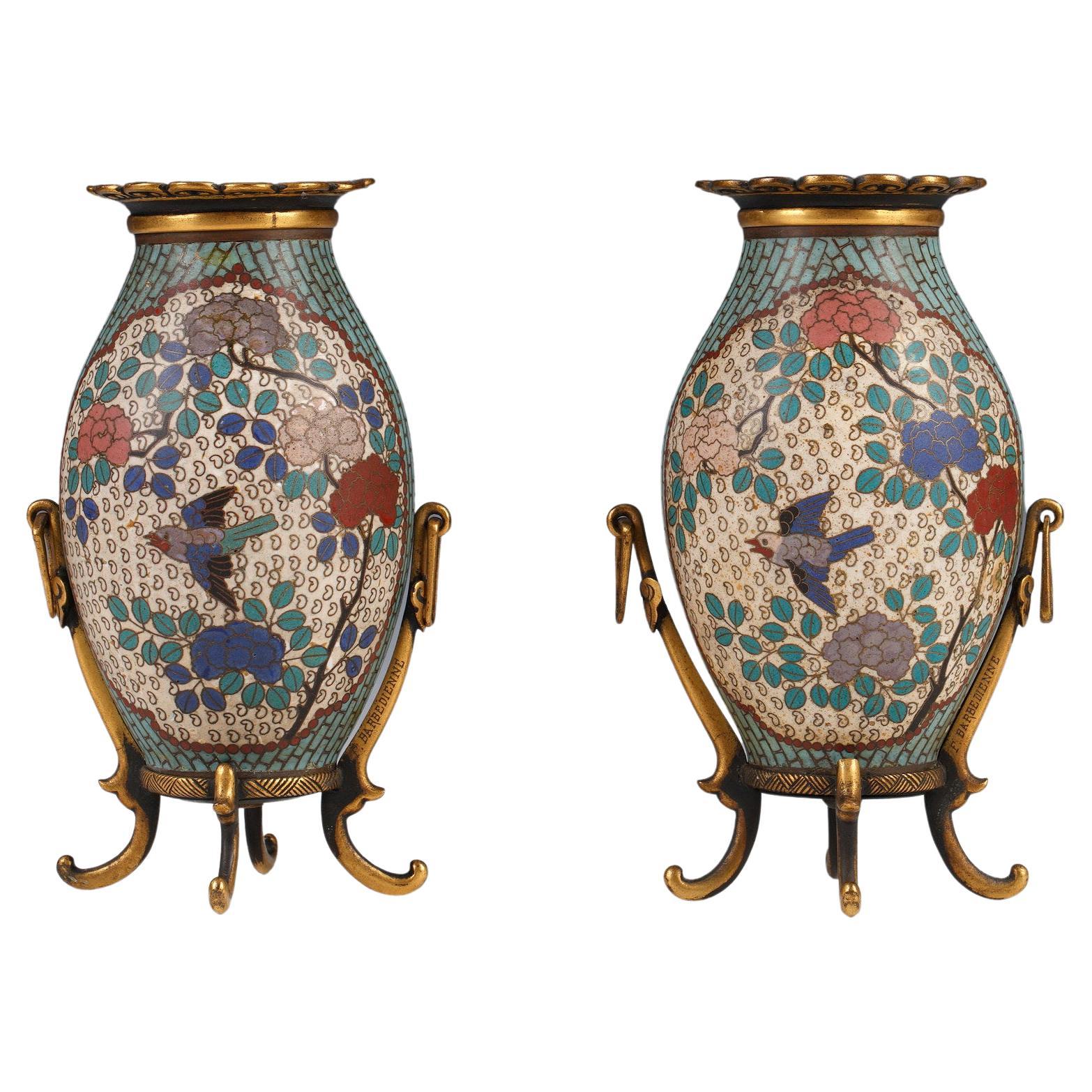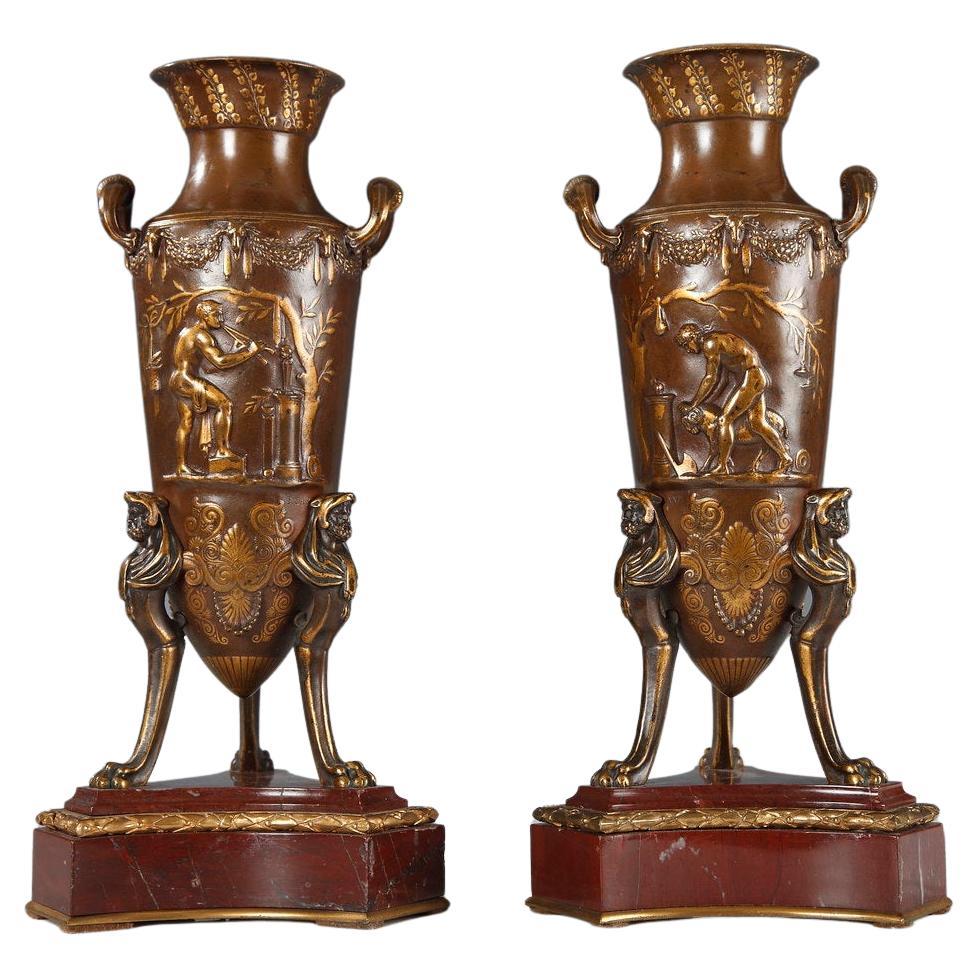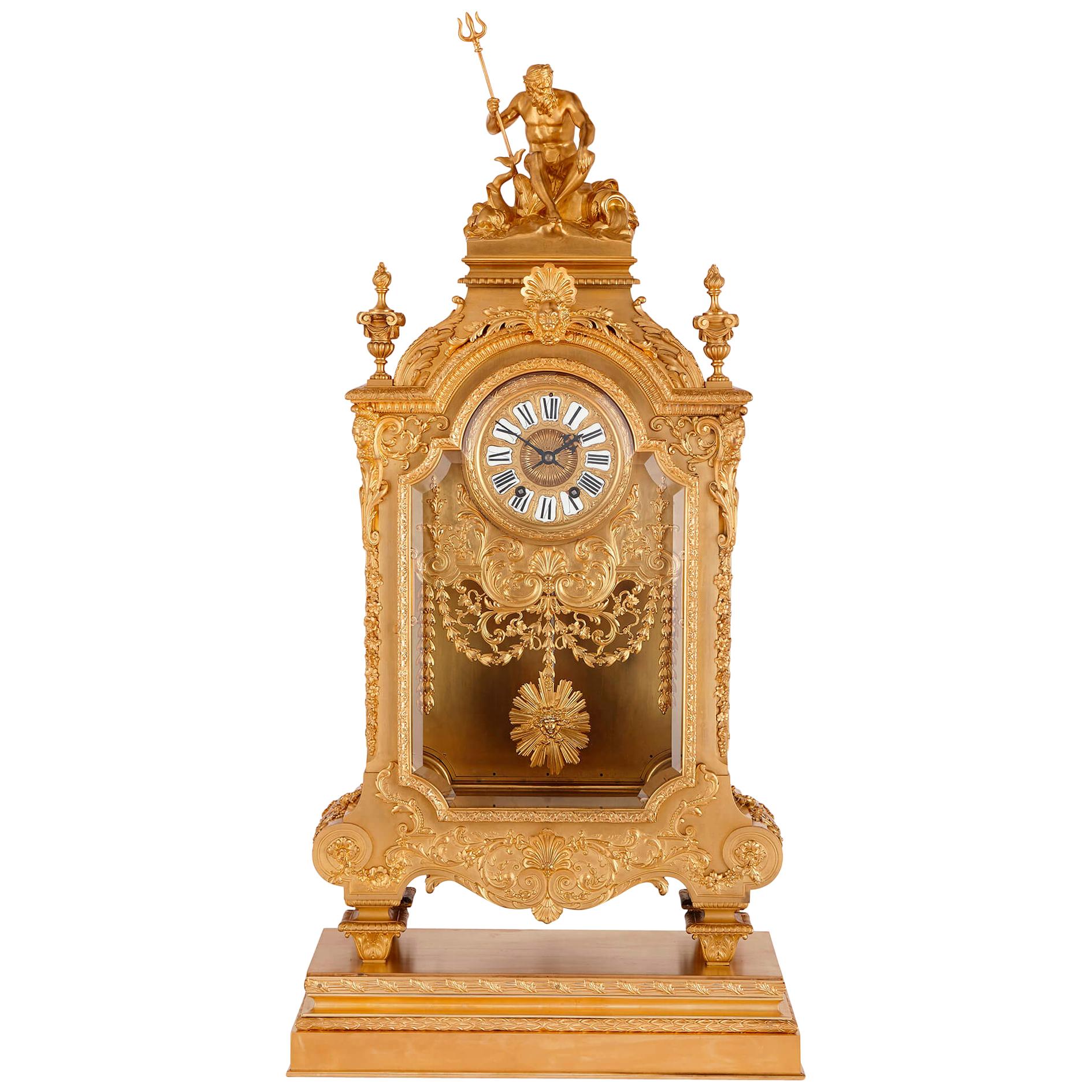Items Similar to Pair of Trumpet-Shaped Byzantines Vases, L.C. Sevin&F. Barbedienne, France, 1880
Want more images or videos?
Request additional images or videos from the seller
1 of 10
Pair of Trumpet-Shaped Byzantines Vases, L.C. Sevin&F. Barbedienne, France, 1880
About the Item
Signed F. Barbedienne
A pair of charming trumpet-shaped vases in gilt bronze with a polychrome cloisonné enamel decoration, one blue and the other green and red. They feature two annular handles and stand on four feet surmounted by a stylized palm. The vases are ornated with a Byzantine decoration.
The high quality of the enamel is typical of Barbedienne’s production. It enhances this pair of vases especially with the wide range of colours used to create the decoration. The enamel is smooth and shiny and shows many shades to form the Byzantine decoration. The partitioned cloisonné is finely engraved and contributes to the decoration by adopting vegetal and foliage shapes.
The Model
These two vases can be linked to a vase presented by Ferdinand Barbedienne at the 1862 London Universal Exhibition and purchased at this time by the South Kensington Museum (now the Victoria and Albert Museum, London, Inv. 8026-1862). This vase has on its belly a polychrome cloisonné enamel decoration standing out against a turquoise background as show these vases. This decoration, called Byzantine, covers all the vase with coloured arabesques and scrolls. It rests on four claw feet with lion heads from a design near of our vases.
Barbedienne and the Cloisonné Enamel
Ferdinand Barbedienne continously innovated and he revived the use of enamel on art works during the second half of the 19th century. The Sèvres Manufacture enamel workshop had ever tried it in 1854-1855, but Barbedienne was the one who succeeded to join enamel to an industrial decorative objects production. From 1858 “At Mr Barbedienne’s, enamels in copper ornaments have got their former prestige back” (Les bronzes de la Maison Barbedienne, C. Simon, in L’Art du XIXe siècle, 1858, n°21, p. 252). The Barbedienne Company had now an enamel workshop where objects ornamented with oriental style or medieval style enamels were made. Four years after, Barbedienne’s cloisonné opaque enamels are noticed during the 1862 Universal Exhibition. Barbedienne was awarded three medals in three different categories : ‘Furniture’, ‘Silversmith work’ and ‘Artistic bronzes’ especially for the combination of bronze with enamel (oriental style cup, Compiègne Castle, Inv. C. 71-122).
The technique used to make these vases is different from the traditional one used for cloisonné enamel. In fact in Barbedienne’s productions the cloisonné is not welded to the object but is directly cast with it. The cloisonné forms part of the object and this innovation enabled to have a more refined and softer decoration.
The colours used by the Barbedienne Company also relate to the success of its enamels and the shades are praised as they “have more than the others these qualities of sparkle and richness that the range of colours of Gothic and Chinese enamellers also have” (in Gazette des Beaux-Arts, 1er décembre 1862, p. 542). This was made to create original enamelled creations either with Chinese or Japanese inspiration with a naturalistic decoration, or with Persian or Indian inspiration with a more stylized decoration, like on these vases.
Biographies
Louis-Constant Sévin (1821-1888) : he was first trained to design and sculpture with the sculptor Antoine-André Marneuf (1796-1865). In 1839 he went into partnership with two sculptors, Phénix and Joyau, and he created designs for famous goldsmiths such as Denière, Froment-Meurice and Morel. He fled to London during the 1848 Revolution where he worked at Morel, with whom he exhibited art works at the 1851 Universal Exhibition. Back to France he took part to the 1855 Universal Exhibition by creating designs to the Limoges porcelain makers Jouhanneaud and Dubois. Since then he worked as head decorator at Ferdinand Barbedienne’s Company. He produced a lot of works : he designed the bronze decoration for the Paiva’s Hotel (on the Champs-Elysées avenue) and created models for Ferdinand Barbedienne. He participated in different exhibitions and was awarded at the 1862 London Universal Exhibition for the artistical excellence of the furniture items he designed and which are exhibited by Barbedienne. He also received a Gold Medal as collaborator at the 1863 Central Union of Decorative Arts Exhibition.
Ferdinand Barbedienne (1810-1892) : he created and headed at n°30 boulevard Poissonnière in Paris one of the most famous 19th century artistic bronze casting companies. Awarded with two Council Medals at the 1851 London Universal Exhibition, the Barbedienne companie won at the 1855 Paris Universal Exhibition a medal of honour and eleven cooperator's medals for the work of his co-workers, such as his designer Louis-Constant Sévin (1821-1888) and his chaser Désiré Attarge (c.1820-1878). At the London Universal Exhibition of 1862 Barbedienne won medals in three different categories : ‘Furniture’, ‘Silversmith work’ and ‘Artistic bronzes’, combining for some pieces with onyx marble and enamel. Barbedienne was not only, with the Parisian silversmith Christofle, one of the leaders of the French Aesthetic Movement in decorative arts, but also the first artist to produce the famous cloisonné enamels (see « L’émaillerie moderne », Gazette des Beaux-Arts, Alfred Darcel, t. XXIV, janv.-juin 1868, p° 75-84). At the 1867 Universal Exhibition in his capacity as member of and speaker for the Jury, he was non-contestant, but exhibited nevertheless with great success cloisonné and champlevé enamelled pieces. Barbedienne was made an Officer of the Légion d'Honneur in 1867 and Commander in 1878 when he was compared with “a prince of industry and the king of bronze casting”. His glory did not decline with the passage of the time for at the Universal Exhibition of 1889 the critics thanked Barbedienne for the example he set for other bronze-casters by the perfection of his bronzes.
Bibliography :
- L’Art en France sous le Second Empire, Exposition Grand-Palais, Paris, 1979, p. 148-149.
- L’émaillerie moderne, Alfred Darcel, in Gazette des Beaux-Arts, t. XXIV (janvier-juin1868), p. 76.
- De l’Impresionisme à l’Art Nouveau – Acquisitions du Musée d’Orsay 1990-1996, Exposition Musée d’Orsay, Paris, 1996, p. 91.
- Les bronzes de la Maison Barbedienne, C. Simon, in L’Art du XIXe siècle, 1858, n°21, p. 252.
- Gazette des Beaux-Arts, 1er décembre 1862, p. 542.
Museology :
- Vase in gilt bronze with enamel decoration presented by F. Barbedienne at the 1862 Universal Exhibition, preserved at the Victoria and Albert Museum, London (Inv. 8026-1862).
- Paire of ornamental vases in gilt bronze with enamel decoration by F. Barbedienne and L.-C. Sévin, preserved at the Orsay Museum, Paris (Inv. OAO 1296 1 et OAO 1296 2).
- Ornamental plate with Persian decoration in copper with enamel, preserved at the Orsay Museum, Paris (Inv. OAO 1493).
- Creator:Ferdinand Barbedienne (Metalworker)
- Attributed to:Louis-Constant Sevin (Artist)
- Dimensions:Height: 9.45 in (24 cm)Diameter: 3.75 in (9.5 cm)
- Sold As:Set of 2
- Style:Other (In the Style Of)
- Materials and Techniques:
- Place of Origin:
- Period:
- Date of Manufacture:Circa 1880
- Condition:Wear consistent with age and use.
- Seller Location:PARIS, FR
- Reference Number:

About the Seller
4.9
Vetted Seller
These experienced sellers undergo a comprehensive evaluation by our team of in-house experts.
Established in 1997
1stDibs seller since 2018
74 sales on 1stDibs
Typical response time: <1 hour
Associations
International Confederation of Art and Antique Dealers' Associations
- ShippingRetrieving quote...Ships From: PARIS, France
- Return PolicyA return for this item may be initiated within 7 days of delivery.
More From This SellerView All
- Pair of Neo-Greek Gueridons Attr. to L.C Sevin & F. Barbedienne, France, c. 1880By Louis-Constant Sevin, Ferdinand BarbedienneLocated in PARIS, FRPair of patinated and gilded bronze high guéridon attributed to L.C Sevin and F. Barbedienne, with for each of them, three paw feet joined by X shaped stretche...Category
Antique 1880s French Greek Revival Gueridon
MaterialsGriotte Marble, Bronze
- Pair of Small Cloisonné Enamel Vases by F. Barbedienne, France, Circa 1880By Ferdinand BarbedienneLocated in PARIS, FRSigned F. Barbedienne on the mount. Charming pair of small curved-shaped vases in patinated and gilded bronze and polychrome cloisonné enamel decorated with flowers and birds. With ...Category
Antique 1880s French Japonisme Vases
MaterialsBronze, Enamel
- Onyx and Bronze Neo-Greek Gueridon Att. to Barbedienne and Sevin, France, c.1880By Louis-Constant Sevin, Ferdinand BarbedienneLocated in PARIS, FRGueridon made in silvered and gilded bronze, composed of four claw feet decorated with lion’s head held together by crossed bars in gilded bronze. It is surmounted by a large onyx to...Category
Antique 1880s French Greek Revival Gueridon
MaterialsOnyx, Bronze
- Japanese Style Tray Attributed to L.-C. Sevin & F. Barbedienne, France, c. 1860By Louis-Constant Sevin, Ferdinand BarbedienneLocated in PARIS, FRRich landscape in cloisonné enamel on blue and brown background imitating Aventurine stone, attributed to L.C. Sevin and F. Barbedienne. The decor represents a river surrounded by wi...Category
Antique 1860s French Japonisme Centerpieces
MaterialsEnamel, Bronze
- Pair of Neo-Greek Amphora Vases by Barbedienne and Levillain, France, circa 1880By Ferdinand Levillain, Ferdinand BarbedienneLocated in PARIS, FRPair of Greek style vases made two patina bronze. Each, designed in the shape of a tripod amphora adorned with Hercules heads, is decorated in low-relief...Category
Antique 1880s French Greek Revival Vases
MaterialsGriotte Marble, Bronze
- Pair of Trumpet Vases Attributed to A. Giroux, France, Circa 1880By Alphonse Giroux et CieLocated in PARIS, FRElegant pair of trumpet-shaped vases attributed to A. Giroux, with flare neck in engraved crystal decorated with leafy interlacing and beads friezes. Removable, they are enclosed in ...Category
Antique 1880s French Vases
MaterialsCrystal, Enamel, Bronze
You May Also Like
- Exceptional Pair of Vases by Louis Constant Sevin and Ferdinand BarbedienneBy Ferdinand BarbedienneLocated in New York, NYAn exceptional pair of French Ormolu and Champleve Enamel vases by Louis Constant Sevin and Ferdinand Barbedienne, circa 1860. "A Pair of Monumen...Category
Antique 19th Century French Napoleon III Vases
MaterialsBronze, Enamel
- Extremely Rare Pair of Ferdinand Barbedienne Ormolu and Champlevé Enamel VasesBy Ferdinand Barbedienne, Louis-Constant SevinLocated in New York, NYAn extremely rare, museum quality pair of Ferdinand Barbedienne ormolu and champlevé enamel vases, circa 1870, certainly designed by Louis Constant Sevin...Category
Antique 19th Century French Napoleon III Vases
MaterialsEnamel, Ormolu
- An Exceptional Pair of Champleve Enamel Ormolu Candelabra by Sevin & BarbedienneBy Ferdinand Barbedienne, Louis-Constant SevinLocated in New York, NYIlluminating Heritage: An Important "Exhibition" Pair of Ferdinand Barbedienne and Louis Constant Sevin Champleve Enamel and Ormolu Eight-Light Candelabra / Lamps In the realm of de...Category
Antique 19th Century French Napoleon III Candelabras
MaterialsBronze, Enamel, Ormolu
- Antique Gilt Bronze Mantel Clock by Sevin and BarbedienneBy Ferdinand Barbedienne, Louis-Constant SevinLocated in London, GBThis ormolu clock is an exemplary work by the famous French 19th century metalworker and foundry-owner, Ferdiand Barbedienne. Working with a design made by the acclaimed onamentalist, Louis-Constant...Category
Antique Late 19th Century French Neoclassical Mantel Clocks
MaterialsOrmolu, Bronze
- Ferdinand Barbedienne, a French Ormolu and Champleve Enamel Jardiniere, C. 1870By Ferdinand Barbedienne, Louis-Constant SevinLocated in New York, NYFerdinand Barbedienne, A French Ormolu and Champleve Enamel Jardiniere, C. 1870, The Design Attributed to Louis Constant Sevin. An exceptional qualit...Category
Antique 19th Century French Napoleon III Decorative Bowls
MaterialsBronze, Enamel, Ormolu
- Ferdinand Barbedienne, A French Ormolu and Champleve Enamel Jardiniere, C. 1870By Ferdinand Barbedienne, Louis-Constant SevinLocated in New York, NYFerdinand Barbedienne, A French Ormolu and Champleve Enamel Jardiniere, C. 1870, The Design Attributed to Louis Constant Sevin. An exceptional qualit...Category
Antique 19th Century French Napoleon III Planters, Cachepots and Jardini...
MaterialsBronze, Enamel, Ormolu
Recently Viewed
View AllMore Ways To Browse
Innovation C
Chinese Porcelain Vase Cloisonne
Pair Of Cloisonne Plates
P L Limoge Vase
Limoges China Vase
Empire Speaker
Vessel With Feet
Japanese Pair Blue Vase
Pair Cloisonne Vases Antique
Japanese Bronze Cast Vases
Japanese Cast Bronze Vases
Limoges Gold Gilt Vases
Limoge China Set
P L Limoges France
P L Limoges
Bronze Two Handled Porcelain Vase
Antique Gold Plated China Cups
Pair F Chinese Vases





